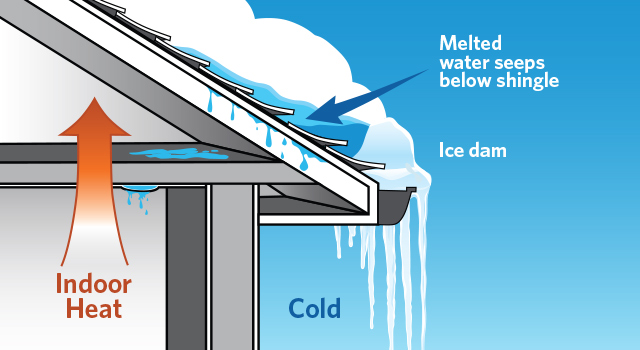Icicles hanging from your home’s roof may look dazzling, but they can also be a sign of ice dams. And if an ice dam gets big enough, it can cause severe damage to your home. Fortunately, there are ways to prevent these winter hazards from ever forming.

How Ice Dams Form
Ice dams usually form after a heavy snowfall followed by a period of freezing temperatures. Here’s what happens:
- Warm air inside your home reaches the attic and heats up the underside of the roof.
- The warmed-up roof causes the snow and ice on it to melt.
- The melted water drains down the roof until it reaches the cold overhang. The overhang is colder than the roof because it hangs beyond the attic.
- The ice buildup at the overhang prevents the melted water from running off the roof.
- The water seeps under the shingles and flows into your attic. From there, it may even leak through to the ceiling and walls below.
Potential Damage
Ice dams may not seem destructive, but they can cause severe damage to your home. If left untreated, they can:
- Ruin attic insulation
- Loosen shingles
- Tear off gutters
- Stain ceilings and walls
- Cause paint to peel
- Ruin sheetrock
- Warp floors
- Lead to mold and mildew
Prevention Tips
There are a few things homeowners can do to help keep ice dams away.
- Clear your gutters. Doing this before the first snowfall will help prevent ice buildup that can causes gutters to break away from the house. Make sure your downspouts are functioning properly too.
- Insulate your attic. The goal is to keep the underside of your roof the same temperature as the outside air. Make sure your attic is properly insulated so warm air from below doesn’t reach the attic. You may need to seal some leaks, especially around air ducts.
- Ensure proper ventilation. Houses with good attic ventilation are less likely to experience ice dams. Good air flow helps keep the temperature cold and may help prevent snow on the roof from melting.
Some of the tasks discussed on this page are potentially dangerous. When in doubt, your best option is to hire a professional.
Safety Tips
If an ice dam does form, please follow these safety tips:
- Don’t go on the roof, as it could be slippery and treacherous.
- Don’t “chip” at the ice from below. You could be injured by the falling ice or damage the shingles.
- To remove snow from the roof, use a long-handled broom or roof rake.
- To remove ice from the roof, fill an old pair of nylon stockings with a calcium chloride ice melt. Then lay the stockings on top of the ice—you may need to use a long-handled broom for this step. The calcium chloride should melt through the ice, creating a route for the water to flow off the roof.
